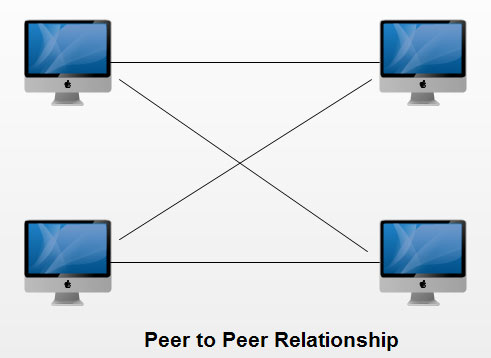
 |
||
| BASIC NETWORK |
NETWORK ARCHITECTURE |
NETWORK TOPOLOGY |
| PEER TO PEER (P2P) |
CLIENT-SERVER |
| DEFINITION A peer-to-peer (P2P) network is created when two or more PCs are connected and share resources without going through a separate server computer |
DEFINITION Network in which one or more computers act as a server, and the other computers (clients) on the network request services from the server. |
DIAGRAM |
DIAGRAM |
| ADVANTAGES 1) It is easy to install and so
is the configuration of computers on this network, |
ADVANTAGES 1) Centralization : Unlike P2P, where there is no central administration, here in this architecture there is a centralized control. Servers help in administering the whole set-up. Access rights and resource allocation is done by Servers. 2) Proper Management : All the files are stored at the same place. In this way, management of files becomes easy. Also it becomes easier to find files. 3) Back-up and Recovery possible : As all the data is stored on server its easy to make a back-up of it. Also, in case of some break-down if data is lost, it can be recovered easily and efficiently. While in peer computing we have to take back-up at every workstation. 4) Upgradation and Scalability in Client-server set-up : Changes can be made easily by just upgrading the server. Also new resources and systems can be added by making necessary changes in server. |
| DISADVANTAGES 1) In this network, the whole system is decentralized thus it is difficult to administer. That is one person cannot determine the whole accessibility setting of whole network. 2) Security in this system is very less viruses, spywares,trojans, etc malwares can easily transmitted over this P-2-P architecture. 3) Data recovery or backup is very difficult. Each computer should have its own back-up system 4) Lot of movies, music and other copyrighted files are transferred using this type of file transfer. P2P is the technology used in torrents. |
DISADVANTAGES 1) Congestion in Network :Too many requests from the clients may lead to congestion, which rarely takes place in P2P network. Overload can lead to breaking-down of servers. In peer-to-peer, the total bandwidth of the network increases as the number of peers increase. 2) Client-Server architecture is not as robust as a P2P and if the server fails, the whole network goes down. Also, if you are downloading a file from server and it gets abandoned due to some error, download stops altogether. However, if there would have been peers, they would have provided the broken parts of file. 3) Cost : It is very expensive to install and manage this type of computing. 4) You need professional IT people to maintain the servers and other technical details of network. |
